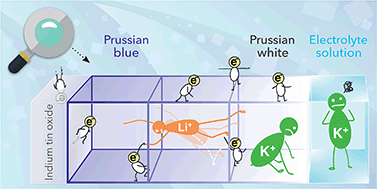東京大学大学院(Graduate School, The University of Tokyo) / 新領域創成科学研究科 複雑理工学専攻, 総合文化研究科 広域科学専攻 相関基礎科学系
Redox-Coupled Alkali-Metal Ion Transport Mechanism in Binder-Free Films of Prussian Blue Nanoparticles

"Redox-Coupled Alkali-Metal Ion Transport Mechanism in Binder-Free Films of Prussian Blue Nanoparticles", M. Ishizaki, H. Ando, N. Yamada, K. Tsumoto, K. Ono, H. Sutoh, T. Nakamura, Y. Nakao, and M. Kurihara, J. Mater. Chem. A 7, 4777 (2019). 【Abstract】 Prussian blue (PB), an archetypal classic porous coordination polymer, has been rediscovered as a potential electrode material for ion secondary batteries due to its accommodations for alkali-metal ions. Many researchers have investigated the charge/discharge capacities of PB and its analogue (PBA) cells with binders. Binders, however, often obscure the underlying redox-coupled ion transport mechanism and the intrinsic transport pathways in PB and PBAs. Using binder-free PB film electrodes prepared by our low-temperature annealing method, we monitored the redox process accompanied by ion transport through simultaneous electrochemical and electrochromic measurements. We clarify that large pores of the defect lattice PB facilitate the efficient transport of bare and solvated Li+/K+, whereas small pores of the perfect lattice PB only allow bare Li+ to be transported up to inner lattice layers. This highlights the importance of pore/ion size selectivity and the (de)solvation effect. Quantum chemical calculations of a perfect lattice model revealed the size-dependent transport pathways of bare Li+ and K+, which microscopically corroborate the experimentally observed selectivity. In addition, spin density difference maps demonstrate that the Li+ transport can be facilitated not only by the electrochemical reduction of all FeIII centres but also by Li+-induced local redox reactions of the lattice framework. Our combined experimental and theoretical studies provide a fundamental understanding of the concealed structure–property relationship in PB films, thereby contributing to a more systematic design of high-performance PB/PBA electrodes.